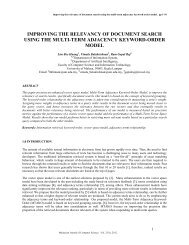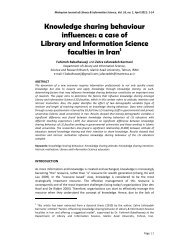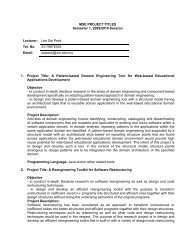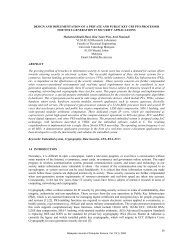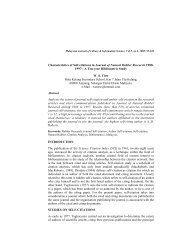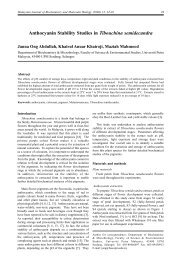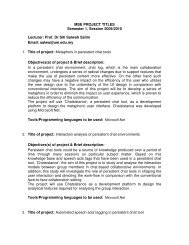Proteomic Analysis of Snakehead Fish (Channa striata ... - EJUM
Proteomic Analysis of Snakehead Fish (Channa striata ... - EJUM
Proteomic Analysis of Snakehead Fish (Channa striata ... - EJUM
Create successful ePaper yourself
Turn your PDF publications into a flip-book with our unique Google optimized e-Paper software.
<strong>Proteomic</strong> analysis <strong>of</strong> snakehead fish muscle tissue31protein, calcium ion binding protein, DNA/RNA-bindingprotein and signal transduction protein, which made up aminor constituent that consist <strong>of</strong> less than 2.4 % <strong>of</strong> thetotal protein detected. Moreover, a series <strong>of</strong> hypotheticalproteins or unknown gene products (about 8.2 % <strong>of</strong> thetotal proteins) were also identified in this study. Generally,hypothetical proteins are still considered as a group <strong>of</strong>proteins that have no indication about their existence atthe protein level. Most <strong>of</strong> them have been only describedat the nucleic acid level as well as predicted from cDNAsequences but were never been identified by proteinchemical method so far [12,13].The major group <strong>of</strong> enzymes identified belonged tosarcoplasmic proteins, which is mainly composed <strong>of</strong>enzymes associated with energy-producing metabolism[14]. The identified sarcoplasmic proteins were found toresponsible for the glycolysis activity and ATP hydrolysis.Among the enzymes, kinases are the most frequentlyidentified proteins. It was revealed that twenty-sevenproteins or 31.8 % <strong>of</strong> the total identified proteins werecategorized as kinases. The proportional <strong>of</strong> majorenzymes found in snakehead fish muscle tissue is shownin Figure 5. These enzymes include kinases, aldolase,dehydrogenase, isomerase, enolase and others. Bynumber, six proteins (7.1 %) were responsible for aldolaseactivity. Ten proteins (11.8 %) were classified asdehydrogenase and another six proteins (7.1 %) wereknown as isomerase. Three proteins (3.5 %) were derivedfrom enolase family. A series <strong>of</strong> glycolytic enzymeswere identified in this study. These proteins werePhosphoglucose isomerase-2, Aldolase (also known asFructose 1,6-biphosphate aldolase), Triosephosphateisomerase, Glyceraldehyde-3-phosphate dehydrogenase,Phosphoglycerate kinase, Enolase, Pyruvate kinase andL-lactate dehydrogenase.Number <strong>of</strong> IdentifiedProteins302520151050KinaseAldolaseDehydrogenaseIsomeraseEnzymesEnolaseOthersFigure 5: Various types <strong>of</strong> enzymes identified in <strong>Snakehead</strong>fish muscle tissue.In addition to sarcoplasmic proteins, my<strong>of</strong>ibrillarprotein or structural protein is also made up the majorgroup <strong>of</strong> protein identified in snakehead fish. There werea total <strong>of</strong> six different my<strong>of</strong>ibrillar proteins detected;they were actin (alpha 1, skeletal muscle), actinin (alpha2), actin (alpha 2, smooth muscle, aorta), fast skeletalmyosin light chain 3, myosin heavy chain (fragment) andskeletal muscle actin (fragment). Other than these majorproteins, some minor proteins such as Complement factorBf-1, Brain glycogen phosphorylase Pygb, Pol-likeprotein, Platelet-activating factor acetylhydrolase (is<strong>of</strong>ormIb, alpha subunit b), Pygb protein (Fragment), Replicase/helicase/endonuclease, Reverse transcriptase, Solbleguanylyl cylase alpha2 subunit, ST7 protein and manymore (as listed in Table 1) were also found in snakeheadfish muscle tissue. These proteins were detected as lowabundant proteins in snakehead fish muscle tissue.The list <strong>of</strong> protein identified in snakehead fish muscletissue (Table 1) shown that the glycolytic and ATPmetabolism are the main activities <strong>of</strong> the fish muscletissue. Both <strong>of</strong> these metabolic specializations areessentially required for power locomotor in fish. Thehigh abundance <strong>of</strong> these two groups <strong>of</strong> enzyme togetherwith my<strong>of</strong>ibrillar proteins suggests that snakehead fishmuscle is composed mainly <strong>of</strong> white muscle tissue.ConclusionThe protein pr<strong>of</strong>iles <strong>of</strong> snakehead fish <strong>of</strong> differentsizes that were caught in different months <strong>of</strong> the yearwere compared. The results showed that all the fisheshave similar protein pr<strong>of</strong>iles, where each protein bandconsisted <strong>of</strong> identical proteins. Furthermore, the relativeintensity <strong>of</strong> protein bands <strong>of</strong> all the fishes analyzed isalso similar. In view <strong>of</strong> high demands <strong>of</strong> snakehead fish,culturing <strong>of</strong> the fish is the only solution. The presentdata can be used as a reference for obtaining culturedsnakehead fish most similar in fish muscle proteincomposition to the wild type fish.AcknowledgementsWe would like to thank Universiti Sains Malaysianshort term grant for providing financial support to carryout this project. We also want to extend our gratitudeto National Poison Centre, USM for providinginfrastructure for analysis <strong>of</strong> proteins. Last but notleast we appreciate the PubMed, Swiss Prot and alsothe MatrixScience that supply free protein s<strong>of</strong>tware forprotein identification.



